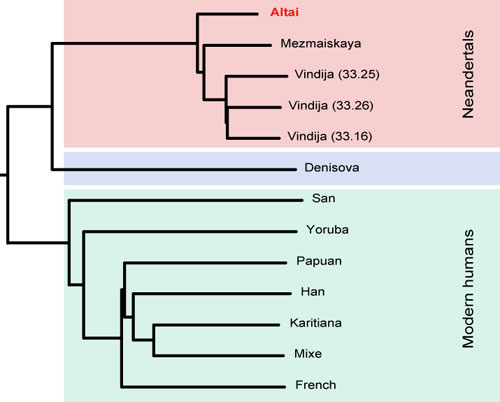A 99.9% complete Neanderthal genome from a toe bone found at Denisova Cave (Altai, Southern Siberia).
Documents at Max Plank Institute for Evolutionary Anthropology, Department of Evolutionary Genetics.
A high-quality Neandertal genome sequence
The genome sequence was generated from a toe bone discovered in Denisova Cave in southern Siberia in 2010. The bone is described in Mednikova (Ethnology & Anthropology of Eurasia 2011. 39: 129-138).
DNA sequences were generated on the Illumina HiSeq platform and constitute an average 50-fold coverage of the genome. 99.9% of the 1.7GB of uniquely mappable DNA sequences in the human genome are covered at least ten times.
Contamination with modern human DNA, estimated from mitochondrial and nuclear DNA sequences, is around 1%.
The figure shows a tree relating this genome to the genomes of Neandertals from Croatia, from Germany and from the Caucasus as well as the Denisovan genome recovered from a finger bone excavated at Deniosva Cave. It shows that this individual is closely related to these other Neandertals. Thus, both Neandertals and Denisovans have inhabited this cave in southern Siberia, presumably at different times.
One may wonder: how can they know it is a Neanderthal and not a "Denisovan"? Because of the close genetic affinity with other Neanderthals from Europe:
It is still possible, considering its position in the tree that the Altai Neanderthal had minor "Denisovan" admixture. But it would be very minor in any case.

This would then be the highest quality Neanderthal genome yet?
ReplyDeleteSo it seems. They could even clone one with so much info I bet...
DeleteI must admit I am less of a cloning skeptic these days as the "Dolly" problem has been solved, and Craig Venter is closing in on the first fully synthetic prokaryote. Still I think that making working eukaryotic chromosomes starting just from an ancient DNA sequence is a couple of generations in the future. Anyway, if one could do that, using the H.s. DNA sequences to fill in the missing 0.1% of the genome would still result in a being who would be Neanderthal by any reasonable definition.
ReplyDeleteA bit speculative but with a 99.9% of the genome and using a H. sapiens cell as base, they could surely do it. Surely not right now but in a matter of decades. The main problem, if I understand it correctly, would be to "knock-in" all the Neanderthal differential SNPs, deletions, insertions in a modern human cell (closest living relative). Technically it's more science than science-fiction today, although more than cloning senso stricto, it'd be massive genetic engineering in order to produce a "clone" of a long dead person (the Denisova Neanderthal) using a modern human cell for the frame.
DeleteHowever it is not ethic nor legal in most countries to clone a human being. Personally I am strongly opposed. Experimenting with human beings only to satisfy our curiosity is pretty much sick.
The quality of this new sequence should allow for a lot of progress.
ReplyDeleteHowever, most importantly, this contains y-DNA. It will be very interesting to see the timing in the uniparental marker compared to (now surely revised) autosomal but also mtDNA estimates.
"this contains y-DNA"...
DeleteReally? The "Denisovan" sequences were all female, so they did not. It could be interesting...